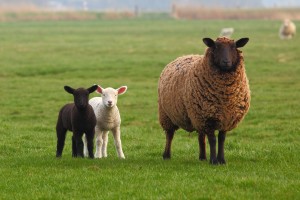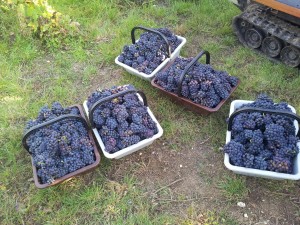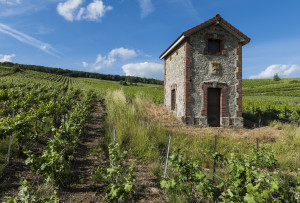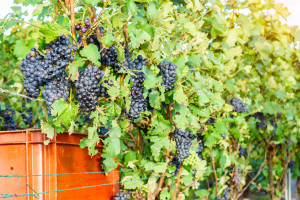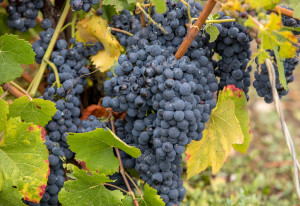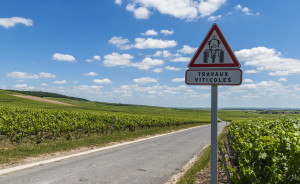Today we have a conference preview from Alan Tardi. In this post, Alan tells us about his upcoming session entitled “Meunier: The Black Sheep of Champagne.” Alan’s session is offered as part SWE’s 43rd Annual Conference, to be held August 14 – 16 in Washington DC.
Meunier Steps Into the Spotlight
It happens with grapevines much as it happens with people: a handful of well-known celebrities attract all the attention and steal the show wherever they go while many others languish in the shadows. There is usually a good explanation for this: Pinot Noir and Chardonnay are rock stars; everyone loves them, and they have a propensity to make superlative wines most everywhere grapevines are grown. More power to them (as if they needed it)!
But sometimes the quirky, less effusive, less generic, less esteemed, sadly overlooked varieties actually have something genuinely worthwhile and thoroughly unique to bring to the table. And getting to know them can be quite enjoyable.
The very large category of overlooked grapes can be divided into two basic groups: truly obscure varieties of uncertain parentage that play a minor—though, some would say, still significant—role even in their primary areas of origin (Petit Meslier and Arbanne in Champagne, for example), and those that are well-established members of their vinous communities and play a notable role in their region’s wine production, but are nevertheless marginalized and treated as second-class citizens.
Malbec, a historically important but largely anonymous player in Bordeaux and Cahors, was a good example of this subgroup before it gained international prestige as the red grape of Argentina. And Meunier is another.
Pinot Meunier is, as its name suggests, an offspring mutation of Pinot Noir, as is Chardonnay, Pinot Gris and Pinot Blanc, which are also approved varieties in Champagne. But unlike the other members of this well-endowed, genetically close-knit but extremely mutable family, Pinot Meunier has not expanded very far outside its area of origin, much less achieved anything close to the star-status of its close relatives.
Though this might be looked upon as a flaw from a commercial standpoint or a major shortcoming for one with international superstar aspirations, it does suggest a special and extremely close affinity with the winegrowing region of Champagne.
It is difficult to determine exactly why, how, when, or where a grape mutation takes place, but it seems likely that the “floury” mutation of Pinot took place on Champagne soil, specifically in the Vallée de la Marne. If true, this would make Meunier the true native son of Champagne (or rather native daughter, since in French the vine is feminine).
Long overshadowed by and openly derided as inferior to Pinot Noir and Chardonnay, Pinot Meunier—or simply Meunier, as the Champenois prefer to call it—has played an important, perhaps even critical, role in Champagne for nearly four centuries. Today it occupies a full third of plantings in the region, and in the 1950s made up nearly 50%!
The Meunier vine buds later and ripens earlier than the other two, making is less prone to devastating frosts which have long been the scourge of this extreme northern growing area, and it is also more resistant to harmful maladies like powdery mildew, downy mildew, coulure and millerandage. To put it bluntly, Meunier has saved Champagne producers’ butts over and over again.
Up until fairly recently, the vast majority of champagne was a harmonious blend of grape varieties and here too, Meunier played an essential but largely unacknowledged role part by contributing fleshy body, fresh ripe fruit, and a pleasant down-to-earthiness to complement Pinot Noir’s firm structure and Chardonnay’s finesse and dazzle. But Meunier can also stand all on its own and, if taken seriously and given the chance, demonstrate facets of Champagne that the others simply can’t.
All this means nothing more (or less) than the fact that the Meunier grape can provide a different, deeper insight into one of the most illustrious wines and winegrowing regions of the world. But how can you get to know what it might offer, whether on its own or in a classic cuvée blend, if you can’t taste it?
Thanks to a small group of winegrowers who have long nurtured the Meunier vine and believed in its potential notwithstanding its second-class status, and a growing number of consumers who are open to and looking for something a bit different, Meunier is finally getting its turn in the spotlight. And here is the chance to get to know it for yourself.
My session, Meunier: The Black Sheep of Champagne will be offered at the Society of Wine Educators 43rd annual conference on August 15, and will include the extraordinary opportunity of tasting nine 100% Meunier wines of Champagne side by side, from four different producers and terroirs in a variety of styles and typologies: red, white and rosé; still (Coteaux Champenois) and sparkling; single-vineyard, perpetual reserve and fortified (ratafia).
This experience will give participants a better understanding of a long underrated grape variety and an entirely different perspective on a wine and a wine-growing region we hold so dearly—Champagne.
A very special thanks to the wineries, and their US importer-distributors, whose generous collaboration has made this presentation possible:
- Geoffroy
- Laherte Frères
- Moussé Fils
- Champagne Salmon
- Skurnik Wines
- Williams Corner Wine
- Polaner Selections
About the speaker: Alan Tardi, former NYC chef and restaurateur, has long worked as a freelance journalist authoring articles about wine and food for numerous publications including The New York Times, Wine & Spirits Magazine, The Wine Spectator, Decanter, Sommelier Journal, and Food Arts. His new book, “Champagne, Uncorked: The House of Krug and the Timeless Allure of the World’s Most Celebrated Drink” (Hachette/PublicAffairs 2016) recently won a Gourmand Best in the World Award in the French Wine category.
Alan’s session, “Meunier: The Black Sheep of Champagne ” will be held on Thursday, August 15 at 8:45 am as part of the Society of Wine Educator’s 43rd Annual Conference, to be held in Washington DC.
Are you a conference speaker that would like to share a preview of your session? Contact Jane A. Nickles at jnickles@societyofwineeducators.org
